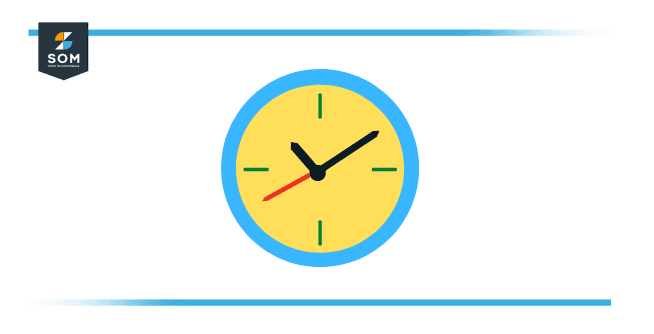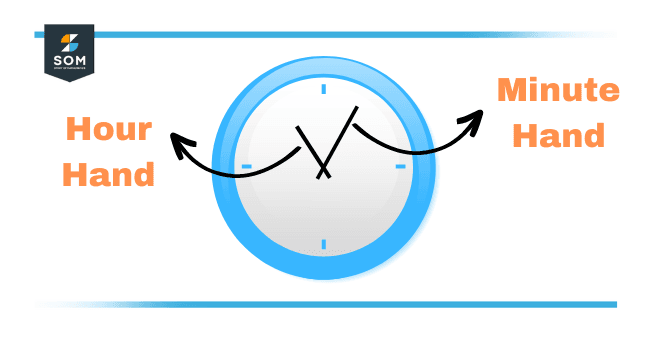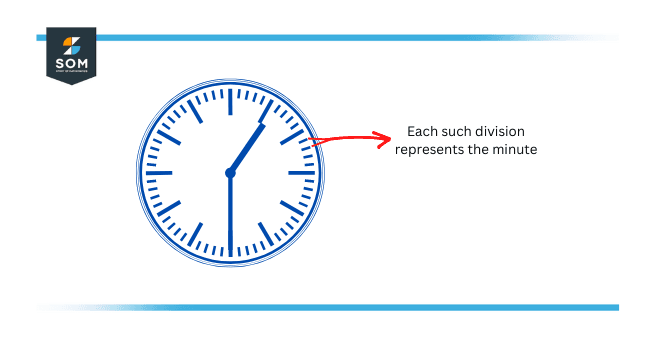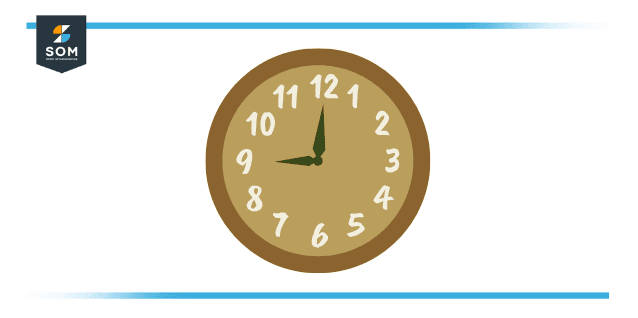JUMP TO TOPIC
Minute Hand|Definition & Meaning
Definition
The big pointer on a timepiece that tells the minutes is called the Minute Hand of the clock. The minute hand finishes one revolution of the clock every 60 minutes.
We all glance at our watch at any moment when we desire to tell the time, even if for going to school or awakening up earlier in the morning. The capability to look through the clock is an essential talent. The knowledge of the idea of time is a significant part of the growth of a kid. It not only helps children academically but also helps them develop a scheduled daily habit.

Figure 1 – Depiction of Clock
Learning time management is a necessary life skill. To understand these skills, it is very crucial for children to comprehend the functioning of a clock.
Hands of a Clock
The timepiece normally has three needles to notify us of time. They are; an hour hand, a minute hand, and a second hand. Some parallel clocks have only 2 hands: the smaller indicator denoting the hour and the lengthier arrow displaying the minutes. The small hand in a clock is named the hour hand, which tells us time in hours, whereas the longer hand, termed the minute hand, tells us time in minutes.

Figure 2 – The Hands of a Clock
An hour is a prolonged span. We normally utilize hours to show when an action takes a longer time span to accomplish. For instance, we usually use hours to tell the time we consume at college or while dozing at night.
A minute is a shorter period of time. We usually use it to notify the time consumed performing a short action. For instance, we use minutes to tell the time we utilize during eating lunch or combing our hair.
A clock has the digits 1 to 12 labeled one after the other on its face or dial. These digits are arranged in equivalent spaces from each other, splitting the face of the clock into 12 equivalent components.
The hour hand in a watch explains the distance of an hour. When the hour hand progresses from one number to the next number on the clock dial, it represents one hour. For instance, when the hour hand progresses from 12 to 1 on the clock dial, it tells us that one hour has proceeded.
Minute Needle in a Clock
In the clock, the minute needle is the longer arrow that indicates the minutes that have ticked by in that hour. In easier terms, it tells the time in minutes.
The span between 2 digits on the clock dial is separated into 5 smaller segments. All of these smaller segments or sections represent one minute.

Figure 3 – Minute Division in a Clock
There are 60 tiny segments on a clock dial. The minute hand moves through these 60 segments when the hour hand advances from one digit to the next one. This indicates that there are sixty minutes in one hour.
How to Read Time to the Minute?
Have a glance at the clock beneath. The minute hand on the clock is aiming at 12, and the hour hand is pointing towards 9, so the time is 9 o’clock. After 1 hour has passed, the hour hand will be at 10, and similarly, the minute hand will be at 12indicating the time as 10 o’clock.

Figure 4 – Reading Clock
In this period of one hour, the hour arrow will shift from 9 to 10. But the minute arrow will drive one whole rotation of the clock dial.
To study the time in minutes, we glance at the digit to which the minute hand pinpoints. We use bounce counting by 5 to study the location of the minute hand on the clock dial, i.e., 5, 10, 15, 20, 25, 30, and so on.
For example, in Figure 1, the hour hand is between 10 and 11. The minute hand is pointing at 2. We miss counting by 5 to decide the minutes that have shifted in that hour 2 times, i.e., 5 and 10. This shows that 10 minutes have proceeded in that hour.
This represents 10 minutes have advanced after 10 o’clock. And we note this time as 10:10. The digit before the colon here illustrates the hour, and the digit after the colon describes the number of minutes that have proceeded since that hour.
The Use of AM and PM
AM and PM are utilized to categorize the time. The full state of a.m is ante meridiem, and the comprehensive interpretation of p.m is post meridiem. The hour before noon is guided to as a.m. The time from 12:00 a.m. to 11:59 a.m. is understood as a.m. P.M. mentions the time between the middle of the day to midnight. The period from 12:00 p.m. to 11:59 p.m. is comprehended as p.m.
Points to Remember
If we separate the clock dial into four quarters, we can study the time effortlessly when the minute hand advances at a certain digit.
- When the minute hand on a clock pinpoints at 12, it denotes the beginning of the next hour.
- When the clock’s minute needle is at 3, it marks 15 minutes have passed of the current hour, and it means that the quarter has passed of that hour. So, we call it quarter past.
When the minute pointer on a timepiece points at 3, we are 15 minutes into the hour. Since the portion of time we have come across resembles like circle’s quarter, we say the time is quarter past 3.
- When the clock’s minute needle is pointing at 6, that means 30 minutes of the hour have passed. Because the movement of the minute needle appears to be half of a circle, we name it half an hour.
- When the clock’s minute needle points at 9, it implies that three-quarters have been passed of the present hour.
When the clock’s minute needle is pointing at 9, it means that 45 minutes of that hour have passed, and we are just required to move one more quarter in order to advance the next hour. We name this as a quarter to 12.
Remember that:
- The minute arrow on a clock moves quicker than the hour hand but moves slower than the second hand.
- The minute hand finishes a single round of the clock dial in 60 minutes, whereas the hour hand does so in 12 hours.
The facts above are helpful when converting between the various units of time.
Clock: Example Problem
Example
Study the time of the clock portrayed in Figure 2.
Solution
In figure 2, the hour hand is pointing at 11, and the minute hand is at 1. We calculate the minutes by miss counting by 5 just 1 time (as per the minute hand’s position), so we get 5. Therefore, the time is 11:05.
All images/mathematical drawings were created with GeoGebra.
